1000+ Anatomy of flowering plant MCQ for UPSC IES [Solved]
Thursday 9th of March 2023

Sharing is caring
1. Some vascular bundles are described as open because these
A. are surrounded by pericycle but not endodermis.
B. are capable of producing secondary xylem and phloem.
C. possess conjunctive tissue between xylem and phloem.
D. are not surrounded by pericycle.
Answer : B
A. are surrounded by pericycle but not endodermis.
B. are capable of producing secondary xylem and phloem.
C. possess conjunctive tissue between xylem and phloem.
D. are not surrounded by pericycle.
Answer : B
2. Cork is formed from
A. phellogen
B. vascular cambium
C. phloem
D. xylem
Answer : A
A. phellogen
B. vascular cambium
C. phloem
D. xylem
Answer : A
3. Which one of the following statement is incorrect ?
A. Only (i)
B. Only (iv)
C. Only (iii)
D. Only (v)
Answer : D
- Epidermal cell has small amount of cytoplasm and a large vacuole.
- Waxy cuticle layer is absent in roots.
- Root hairs are unicellular, while stem hairs / trichomes are multicellular.
- Trichomes may be branched or unbranched, soft or stiff and prevent transpiration.
- Guard cells are dumbell shaped in dicots and beanshaped in monocots (e.g. grass).
A. Only (i)
B. Only (iv)
C. Only (iii)
D. Only (v)
Answer : D
4. Sieve tubes are suited for translocation of food because they possess
A. bordered pits.
B. no ends walls.
C. broader lumen and perforated cross walls.
D. no protoplasm.
Answer : C
A. bordered pits.
B. no ends walls.
C. broader lumen and perforated cross walls.
D. no protoplasm.
Answer : C
5. A vascular bundle in which the protoxylem is pointing to the periphery is called __________.
A. endarch
B. exarch
C. radial
D. closed
Answer : B
A. endarch
B. exarch
C. radial
D. closed
Answer : B
6. Read the following statements and answer the question.
Which type of wood is described by the above statements?
A. Sap wood
B. Heart wood
C. Spring wood
D. Autumn wood
Answer : C
- Cambium is very active and produces a large number of xylary elements having vessels with wider cavities.
- It is also called early wood.
- It is lighter in colour and has lower density.
Which type of wood is described by the above statements?
A. Sap wood
B. Heart wood
C. Spring wood
D. Autumn wood
Answer : C
7. A plant tissue when stained showed the presence of hemicellulose and pectin in cells wall of its cells. The tissue is called
A. collenchyma
B. sclerenchyma
C. xylem
D. meristem
Answer : A
A. collenchyma
B. sclerenchyma
C. xylem
D. meristem
Answer : A
8. Match column-I with column-II and choose the correct option.
Which of the following combination is correct ?
A. A II, IV, VII, VIII; B I, III, V, VI
B. A I, II, VII, VIII; B III, IV, V, VI
C. A I, III, V, VI; B II, IV, VII, VIII
D. A I, III, VII, VIII; B II, IV, V, VI
Answer : C
| A. Spring wood or | I. Lighter in colour early wood |
|---|---|
| B. Autumn wood or | II. High density late wood |
| .. | III. Low density |
| .. | IV. Darker in colour |
| .. | V. Larger number of xylem elements |
| .. | VI. Vessels with wider cavity |
| .. | VII. Lesser number of xylem elements |
| .. | VIII. Vessels with small cavity |
Which of the following combination is correct ?
A. A II, IV, VII, VIII; B I, III, V, VI
B. A I, II, VII, VIII; B III, IV, V, VI
C. A I, III, V, VI; B II, IV, VII, VIII
D. A I, III, VII, VIII; B II, IV, V, VI
Answer : C
9. Match the terms given in column I with their features given in column II and choose the correct option.
A. A - (i), B - (ii), C - (iii), D - (iv), E - (v)
B. A - (iii), B - (v), C - (ii), D - (iv), E - (i)
C. A - (iii), B - (i), C - (v), D - (ii), E - (iv)
D. A - (v), B - (iv), C - (iii), D - (i), E - (ii)
Answer : B
| Column-I | Column-II |
|---|---|
| (Terms) | (Features) |
| A. Fibres | (i) Cells are living and thin walled with cellulosic cell wall, store food materials in the form of starch or fat |
| B. Sclereids | (ii) Main water conductive cells of the pteridophytes and the gymnosperms |
| C. Tracheids | (iii) Thick walled, elongated and pointed cells, generally occurring in groups |
| D. Vessels | (iv) Long cylindrical tube like structure and cells are devoid of protoplasm. Characteristic feature of angiosperms |
| E. Xylem parenchyma | (v) Reduced form of sclerenchyma cells with highly thickened lignified cellular walls that form small bundles of durable layers of tissue in most plants. |
A. A - (i), B - (ii), C - (iii), D - (iv), E - (v)
B. A - (iii), B - (v), C - (ii), D - (iv), E - (i)
C. A - (iii), B - (i), C - (v), D - (ii), E - (iv)
D. A - (v), B - (iv), C - (iii), D - (i), E - (ii)
Answer : B
10. Match the followings and choose the correct option
A. A III, B IV, C I, D II
B. A I, B II, C III, D IV
C. A III, B II, C IV, D I
D. A III, B II, C I, D IV
Answer : A
| Column-I | Column-II |
|---|---|
| A. Cuticle | I. Guard cells |
| B. Bulliform cells | II. Outer layer |
| C. Stomata | III. Waxy layer |
| D. Epidermis | IV. Empty colourless cell |
A. A III, B IV, C I, D II
B. A I, B II, C III, D IV
C. A III, B II, C IV, D I
D. A III, B II, C I, D IV
Answer : A
11. The length of different internodes in a culm of sugarcane is variable because of
A. size of leaf lamina at the node below each internode
B. intercalary meristem
C. shoot apical meristem
D. position of axillary buds
Answer : B
A. size of leaf lamina at the node below each internode
B. intercalary meristem
C. shoot apical meristem
D. position of axillary buds
Answer : B
12. As secondary growth proceeds, in a dicot stem, the thickness of
A. sapwood increases.
B. heartwood increase.
C. both sapwood and heartwood increases.
D. both sapwood and heartwood remains the same.
Answer : C
A. sapwood increases.
B. heartwood increase.
C. both sapwood and heartwood increases.
D. both sapwood and heartwood remains the same.
Answer : C
13. Which of the following statements are correct ?
A. (i) and (iii)
B. (i) and (ii)
C. (iii) and (iv)
D. (i) and (iv)
Answer : B
- Xylem transports water and minerals.
- Gymnosperms lack sieve tubes and companion cells in phloem.
- The first formed primary xylem is called metaxylem.
- Phloem fibres (bast fibres) are made up of collenchymatous cells.
A. (i) and (iii)
B. (i) and (ii)
C. (iii) and (iv)
D. (i) and (iv)
Answer : B
14. Cells of permanent tissues are specialized
A. functionally.
B. only structurally.
C. both structurally and functionally.
D. for mitosis.
Answer : C
A. functionally.
B. only structurally.
C. both structurally and functionally.
D. for mitosis.
Answer : C
15. The __________ occurs in layers below the epidermis in dicotyledonous plants.
A. parenchyma
B. sclerenchyma
C. collenchyma
D. aerenchyma
Answer : C
A. parenchyma
B. sclerenchyma
C. collenchyma
D. aerenchyma
Answer : C
16. A tissue is a group of cells which are
A. similar in origin, but dissimilar in form and function.
B. dissimilar in origin, form and function.
C. dissimilar in origin, but similar in form and function.
D. similar in origin, form and function.
Answer : D
A. similar in origin, but dissimilar in form and function.
B. dissimilar in origin, form and function.
C. dissimilar in origin, but similar in form and function.
D. similar in origin, form and function.
Answer : D
17. Cork cambium and vascular cambium are
A. the parts of secondary xylem and phloem.
B. the parts of pericycle.
C. lateral meristems.
D. apical meristems.
Answer : C
A. the parts of secondary xylem and phloem.
B. the parts of pericycle.
C. lateral meristems.
D. apical meristems.
Answer : C
18. Bast fibres are made up of _____________cells.
A. sclerenchymatous
B. chlorenchymatous
C. parenchymatous
D. aerenchymatous
Answer : A
A. sclerenchymatous
B. chlorenchymatous
C. parenchymatous
D. aerenchymatous
Answer : A
19. Apical and intercalary meristems are primary meristems because
A. they occur in the mature region of roots and shoots of many plants.
B. they made up of different kinds of tissues.
C. they involved in secondary growth.
D. they appear early in life of a plant and contribute to the formation of the primary plant body.
Answer : D
A. they occur in the mature region of roots and shoots of many plants.
B. they made up of different kinds of tissues.
C. they involved in secondary growth.
D. they appear early in life of a plant and contribute to the formation of the primary plant body.
Answer : D
20. Various functions like photosynthesis, storage, excretion performed by _____________.
A. sclerenchyma
B. parenchyma
C. collenchyma
D. aerenchyma
Answer : B
A. sclerenchyma
B. parenchyma
C. collenchyma
D. aerenchyma
Answer : B
21. Which of following helps bamboo and grasses to elongate ?
A. Apical meristems
B. Lateral meristems
C. Secondary meristems
D. Intercalary meristems
Answer : D
A. Apical meristems
B. Lateral meristems
C. Secondary meristems
D. Intercalary meristems
Answer : D
22. In land plants, the guard cells differ from other epidermal cells in having
A. cytoskeleton.
B. mitochondria.
C. endoplasmic reticulum.
D. chloroplasts.
Answer : D
A. cytoskeleton.
B. mitochondria.
C. endoplasmic reticulum.
D. chloroplasts.
Answer : D
23. The trees growing in desert will
A. show alternate rings of xylem and sclerenchyma.
B. have only conjunctive tissue and phloem is formed by the activity of cambium.
C. show distinct annual rings.
D. not show distinct annual rings.
Answer : D
A. show alternate rings of xylem and sclerenchyma.
B. have only conjunctive tissue and phloem is formed by the activity of cambium.
C. show distinct annual rings.
D. not show distinct annual rings.
Answer : D
24. The given figure shows apical meristem of root apex with few part marked as A, B and C. Identify the correct labelling of A, B and C.
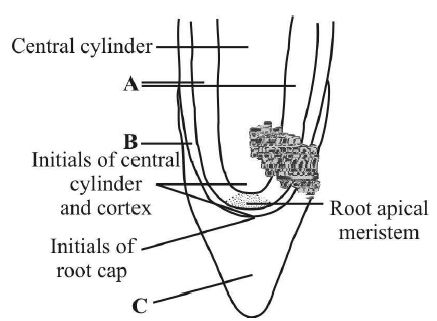
A. A Vascular structure, B Protoderm, C Root cap
B. A Cortex, B Endodermis, C Root cap
C. A Cortex, B Protoderm, C Root cap
D. A Tunica, B Protoderm, C Root cap
Answer : C

A. A Vascular structure, B Protoderm, C Root cap
B. A Cortex, B Endodermis, C Root cap
C. A Cortex, B Protoderm, C Root cap
D. A Tunica, B Protoderm, C Root cap
Answer : C
25. T.S. of dicot stem is given below, certain parts have been marked by alphabets (A I). Choose the option which shows their correct labelling.

A. A Epidermis, B Epidermal hair, C Parenchyma, D Starch sheath, E Hypodermis (collenchyma), F Vascular bundle, G Bundle cap, H Medulla or pith, I Medullary rays
B. A Epidermal hair, B Epidermis, C Hypodermis (collenchyma), D Parenchyma, E Endoderm is (Starch Sheath), F Pericycle, G Vascular bundle, H Medullary rays, I Medulla or pith
C. A Epidermal hair, B Epidermis, C Hypodermis (collenchyma), D Starch sheath, E Parenchyma, F Vascular bundle, G Bundle cap, H Medulla or pith, I Medullary rays
D. A Epidermal hair, B Epidermis, C Parenchyma, D Hypodermis (collenchyma), E Starch sheath, F Vascular bundle, G Bundle cap, H Medulla or pith, I Medullary rays
Answer : B

A. A Epidermis, B Epidermal hair, C Parenchyma, D Starch sheath, E Hypodermis (collenchyma), F Vascular bundle, G Bundle cap, H Medulla or pith, I Medullary rays
B. A Epidermal hair, B Epidermis, C Hypodermis (collenchyma), D Parenchyma, E Endoderm is (Starch Sheath), F Pericycle, G Vascular bundle, H Medullary rays, I Medulla or pith
C. A Epidermal hair, B Epidermis, C Hypodermis (collenchyma), D Starch sheath, E Parenchyma, F Vascular bundle, G Bundle cap, H Medulla or pith, I Medullary rays
D. A Epidermal hair, B Epidermis, C Parenchyma, D Hypodermis (collenchyma), E Starch sheath, F Vascular bundle, G Bundle cap, H Medulla or pith, I Medullary rays
Answer : B
26. Phellogen and phellem respectively denote
A. cork and cork cambium,
B. cork cambium and cork,
C. secondary cortex and cork,
D. cork and secondary cortex,
Answer : B
A. cork and cork cambium,
B. cork cambium and cork,
C. secondary cortex and cork,
D. cork and secondary cortex,
Answer : B
27. During the formation of leaves and elongation of stem, some cells left behind from the shoot apical meristem, constitute the
A. lateral meristem
B. axillary bud
C. cork cambium
D. fascicular cambium
Answer : B
A. lateral meristem
B. axillary bud
C. cork cambium
D. fascicular cambium
Answer : B
28. A student was given a tissue to observe under the microscope. He observes the tissue and concludes that the tissue is a type of simple plant tissue and provides mechanical support to young stem and petiole of leaf.
Identify the tissue.
A. Parenchyma
B. Collenchyma
C. Sclerenchyma
D. Xylem parenchyma
Answer : B
Identify the tissue.
A. Parenchyma
B. Collenchyma
C. Sclerenchyma
D. Xylem parenchyma
Answer : B
29. Which meristem helps in increasing girth?
A. Lateral meristem
B. Intercalary meristem
C. Primary meristem
D. Apical meristem
Answer : A
A. Lateral meristem
B. Intercalary meristem
C. Primary meristem
D. Apical meristem
Answer : A
30. A common structural feature of vessel elements and sieve tube elements are
A. pores on lateral walls.
B. presence of p-protein.
C. enucleate condition.
D. thick secondary walls.
Answer : C
A. pores on lateral walls.
B. presence of p-protein.
C. enucleate condition.
D. thick secondary walls.
Answer : C
31. The given figures are types of elements (A and B) which constitute one type of complex tissue (c) of a plant . Identify A, B and C.
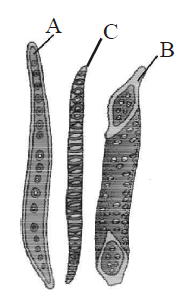
A. A Tracheid, B Vessel, C Xylem
B. A Vessel, B Tracheild, C Phloem
C. A Fibre, B Tracheid, C Bark
D. A Fibre, B Sclereid, C Casparian strips
Answer : A

A. A Tracheid, B Vessel, C Xylem
B. A Vessel, B Tracheild, C Phloem
C. A Fibre, B Tracheid, C Bark
D. A Fibre, B Sclereid, C Casparian strips
Answer : A
32. Tissues are classified into two main groups, namely meristematic and permanent tissues on the basis of
A. whether the cells being able to divide or not.
B. position of the cells.
C. whether they are living or dead.
D. none of the above
Answer : A
A. whether the cells being able to divide or not.
B. position of the cells.
C. whether they are living or dead.
D. none of the above
Answer : A
3. Identify the types of simple tissue indicated by A, B, C and D and their function.
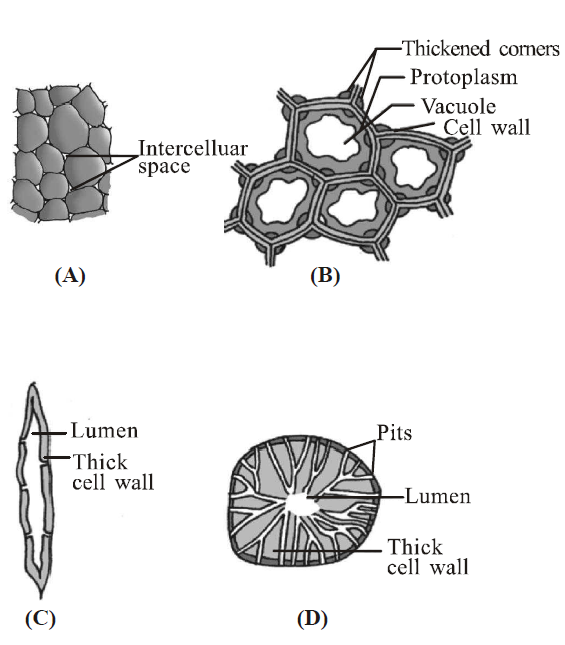
A. A Parenchyma, Photosynthesis, Storage and Secretion.
B. B Sclerenchyma Scleriods; Transport food material
C. C Collenchyma; Provides mechanical support to organs.
D. D Sclerenchyma Fibres; Provide Mechanical support to the growing parts of the plant such as young stem and petiole of a leaf.
Answer : A

A. A Parenchyma, Photosynthesis, Storage and Secretion.
B. B Sclerenchyma Scleriods; Transport food material
C. C Collenchyma; Provides mechanical support to organs.
D. D Sclerenchyma Fibres; Provide Mechanical support to the growing parts of the plant such as young stem and petiole of a leaf.
Answer : A
34. Which of the following figure is a type of permanent tissue having many different types of cell?
A.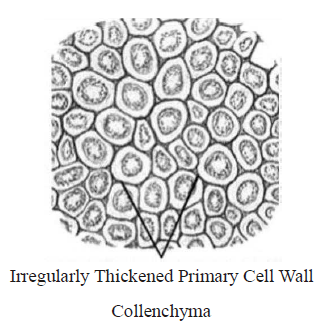
B.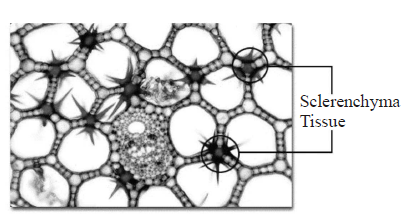
C.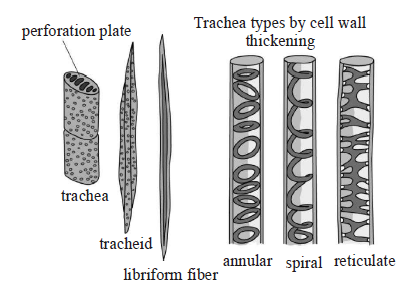
D.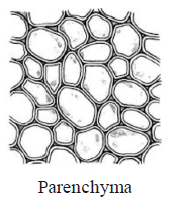
Answer : C
A.

B.

C.

D.

Answer : C
35. Which of the following statements is correct?
A. Lenticels occur in most woody trees.
B. Sclerenchymatous cells are usually present in cortex.
C. The vascular tissue system is divided into three main zones- cortex, pericycle and pith.
D. The conjoint vascular bundles usually have the xylem located only on the outer side of the phloem.
Answer : A
A. Lenticels occur in most woody trees.
B. Sclerenchymatous cells are usually present in cortex.
C. The vascular tissue system is divided into three main zones- cortex, pericycle and pith.
D. The conjoint vascular bundles usually have the xylem located only on the outer side of the phloem.
Answer : A
36. When we peel the skin of a potato tuber, we remove
A. periderm
B. epidermis
C. cuticle
D. leaves
Answer : A
A. periderm
B. epidermis
C. cuticle
D. leaves
Answer : A
37. Choose the correct labelling of (A J) in the given figure of T.S. of monocot root.

A. A Root hair, B Epiblema, C Cortex, D Endodermis, E Passage cell, F Pericycle, G Pith, H Phloem, I Metaxylem.
B. A Root hair, B Epiblema, C Cortex, D Endodermis, E Passage cell, F Pith, G Pericycle, H Metaxylem, I Phloem.
C. A Root hair, B Epiblema, C Cortex, D Endodermis, E Pericycle, F Phloem, G Protoxylem, I Metaxylem
D. A Root hair, B Cortex, C Epiblema, D Pericycle, E Endodermis, F Pith, G Phloem, H Protoxylem, I Metaxylem
Answer : C

A. A Root hair, B Epiblema, C Cortex, D Endodermis, E Passage cell, F Pericycle, G Pith, H Phloem, I Metaxylem.
B. A Root hair, B Epiblema, C Cortex, D Endodermis, E Passage cell, F Pith, G Pericycle, H Metaxylem, I Phloem.
C. A Root hair, B Epiblema, C Cortex, D Endodermis, E Pericycle, F Phloem, G Protoxylem, I Metaxylem
D. A Root hair, B Cortex, C Epiblema, D Pericycle, E Endodermis, F Pith, G Phloem, H Protoxylem, I Metaxylem
Answer : C
38. Which one of the followings option shows the correct labelling of the parts marked as A, B, C and D in the given figure a lenticel?
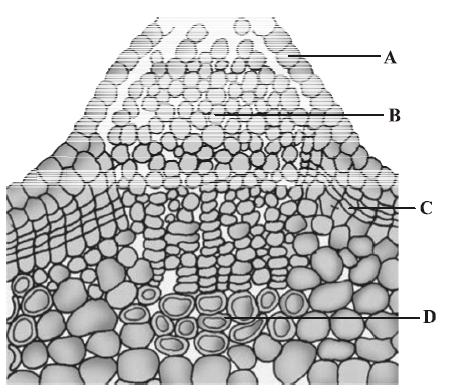
A. A Epidermis, B Secondary cortex, C Cork cambium, D Cork
B. A Pore, B Cork cambium, C Secondary cortex, D Cork
C. A Pore, B Cork, C Complimentary cells, D Cork cambium
D. A Epidermis, B Complimentary cells, C Cork cambium, D Secondary cortex
Answer : D

A. A Epidermis, B Secondary cortex, C Cork cambium, D Cork
B. A Pore, B Cork cambium, C Secondary cortex, D Cork
C. A Pore, B Cork, C Complimentary cells, D Cork cambium
D. A Epidermis, B Complimentary cells, C Cork cambium, D Secondary cortex
Answer : D
39. A piece of wood having no vessels (trachea) must be belonged to
A. teak
B. mango
C. pine
D. palm
Answer : C
A. teak
B. mango
C. pine
D. palm
Answer : C
40. Why grafting is successful in dicots ?
A. In dicots vascular bundles are arranged in a ring.
B. Dicots have cambium for secondary growth.
C. In dicots vessels with elements are arranged end to end.
D. Cork cambium is present in dicots
Answer : B
A. In dicots vascular bundles are arranged in a ring.
B. Dicots have cambium for secondary growth.
C. In dicots vessels with elements are arranged end to end.
D. Cork cambium is present in dicots
Answer : B
41. T.S. of dicot leaf passing through the midrib is given below. Certain parts have been marked by alphabets (A to H). Choose the option showing their correct labelling.

A. A Epidermis, B Spongy mesophyll, C Palisade mesophyll, D Stomata, E Guard cells, F Phloem, G Metaxylem, H Protoxylem
B. A Epidermis, B Palisade mesophyll, C Spongy mesophyll, D Sub-stomatal cavity, E Stoma, F Phloem, G Xylem, H Bundle sheath
C. A Epidermis, B Palisade mesophyll, C Spongy mesophyll, D Stomata, E Guard cells, F Epidermis, G Xylem, H Phloem
D. A Epidermis, C Palisade mesophyll, C Spongy mesophyll, D Stomata, E Guard cells, F Phloem, G Metaxylem, H Protoxylem
Answer : B

A. A Epidermis, B Spongy mesophyll, C Palisade mesophyll, D Stomata, E Guard cells, F Phloem, G Metaxylem, H Protoxylem
B. A Epidermis, B Palisade mesophyll, C Spongy mesophyll, D Sub-stomatal cavity, E Stoma, F Phloem, G Xylem, H Bundle sheath
C. A Epidermis, B Palisade mesophyll, C Spongy mesophyll, D Stomata, E Guard cells, F Epidermis, G Xylem, H Phloem
D. A Epidermis, C Palisade mesophyll, C Spongy mesophyll, D Stomata, E Guard cells, F Phloem, G Metaxylem, H Protoxylem
Answer : B
42. The given figure shows the T.S of dicot root. Some parts are marked as A, B, C, D, E, & F. Choose the option which shows the correct labelling of marked part.

A. A Epiblema, B Root hair, C Cortex, D Endodermis, E Pith, F Pericycle
B. A Cortex, B Pith, C Epiblema, D Endodermis, E Root hair, F Pericycle
C. A Epiblema, B Endodermis, C Cortex, D Root hair, E Pith, F Pericycle
D. A Cortex, B Epiblema, C Pith, D Endodermis, E Root hair, F Pericycle
Answer : D

A. A Epiblema, B Root hair, C Cortex, D Endodermis, E Pith, F Pericycle
B. A Cortex, B Pith, C Epiblema, D Endodermis, E Root hair, F Pericycle
C. A Epiblema, B Endodermis, C Cortex, D Root hair, E Pith, F Pericycle
D. A Cortex, B Epiblema, C Pith, D Endodermis, E Root hair, F Pericycle
Answer : D
43. In the given columns, column I contain structures of female reproductive system and column II contain its feature. Select the correct match.
A. A - (i), B - (ii), C - (iii), D - (iv)
B. A - (iii), B - (i), C - (ii), D - (iv)
C. A - (i), B - (iv), C - (iii), D - (ii)
D. A - (ii), B - (iv), C - (iii), D - (i)
Answer : A
| Column-I | Column-II |
|---|---|
| A. Lateral meristem | (i) Fascicular vascular cambium, interfascicular cambium and cork cambium. |
| B. Apical meristem | (ii) Produces dermal tissue, ground tissues and vascular tissue. |
| C. Bast fibres | (iii) Generally absent in primary phloem but found in secondary phloem. |
| D. Sap wood | (iv) Involved in the conduction of water and minerals from the root to leaf. |
A. A - (i), B - (ii), C - (iii), D - (iv)
B. A - (iii), B - (i), C - (ii), D - (iv)
C. A - (i), B - (iv), C - (iii), D - (ii)
D. A - (ii), B - (iv), C - (iii), D - (i)
Answer : A
44. An organised and differentiated cellular structure having cytoplasm but no nucleus is called _________.
A. vessels
B. xylem parenchyma
C. sieve tubes
D. tracheids
Answer : C
A. vessels
B. xylem parenchyma
C. sieve tubes
D. tracheids
Answer : C
45. Match column-I with column-II and choose the correct option.
A. A III, B V, C IV, D I, E II
B. A II, B V, C I, D III, E IV
C. A II, B IV, C I, D III, E V
D. A III, B I, C V, D II, E IV
Answer : D
| Column -I | Column -II |
|---|---|
| A. Bulliform cells | I. Initiation of lateral roots |
| B. Pericycle | II. Root |
| C. Endarch xylem | III. Grasses |
| D. Exarch xylem | IV. Dicot eaf |
| E. Bundle sheath cells | V. Stem |
A. A III, B V, C IV, D I, E II
B. A II, B V, C I, D III, E IV
C. A II, B IV, C I, D III, E V
D. A III, B I, C V, D II, E IV
Answer : D
46. One of the primary function of the ground tissue in a plant is
A. photosynthesis.
B. to protect the plant.
C. to anchor the plant.
D. water and sugar conduction.
Answer : A
A. photosynthesis.
B. to protect the plant.
C. to anchor the plant.
D. water and sugar conduction.
Answer : A
47. Match the terms given in column I with their funciton given in column II and choose the correct option.
A. A I, B III, C V, D II, E IV
B. A III, B I, C II, D V, E IV
C. A II, B IV, C V, D I, E III
D. A V, B IV, C III, D II, E I
Answer : B
| Column-I | Column-II |
|---|---|
| (Term) | (Functions) |
| A. Meristem | I. Photosynthesis, storage |
| B. Parenchyma | II. Mechanical support |
| C. Collenchyma | III. Actively dividing cells |
| D. Sclerenchyma | IV. Stomata |
| E. Epidermal tissue | V. Sclereids |
A. A I, B III, C V, D II, E IV
B. A III, B I, C II, D V, E IV
C. A II, B IV, C V, D I, E III
D. A V, B IV, C III, D II, E I
Answer : B
48. The apical meristem of the root is present
A. in all the roots.
B. only in radicals.
C. only in tap roots.
D. only in adventitious roots.
Answer : A
A. in all the roots.
B. only in radicals.
C. only in tap roots.
D. only in adventitious roots.
Answer : A
49. Which one of the following have vessels as their characteristic feature?
A. Angiosperms
B. Gymnosperms
C. Pteridophytes
D. Bryophytes
Answer : A
A. Angiosperms
B. Gymnosperms
C. Pteridophytes
D. Bryophytes
Answer : A
50. Which of the following statement(s) is/are not correct?
A. (iii) and (iv)
B. (i) and (ii)
C. (ii) and (iii)
D. (ii) and (iv)
Answer : A
- Cork cambium is also called phellogen.
- Cork is also called phellem.
- Secondary cortex is also called periderm.
- Cork cambium, cork and secondary cortex are collectively called phelloderm.
A. (iii) and (iv)
B. (i) and (ii)
C. (ii) and (iii)
D. (ii) and (iv)
Answer : A
Sharing is caring
Related Post
1000+ Classifications of Animal Kindom Multiple Choice Question Answer [Solved]
Urologic infections and inflammations 1000+ MCQ with answer for GATE
1000+ Current Affairs August 2017 MCQ for RRB NTPC [Solved]
Chemical Engineering Thermodynamics MCQ Solved Paper for NEET
NDA - Current Affairs July 2017 1000+ MCQ [Solved] PDF Download
LIC ADO - Refrigeration & Air-Conditioning 1000+ MCQ [Solved] PDF Download